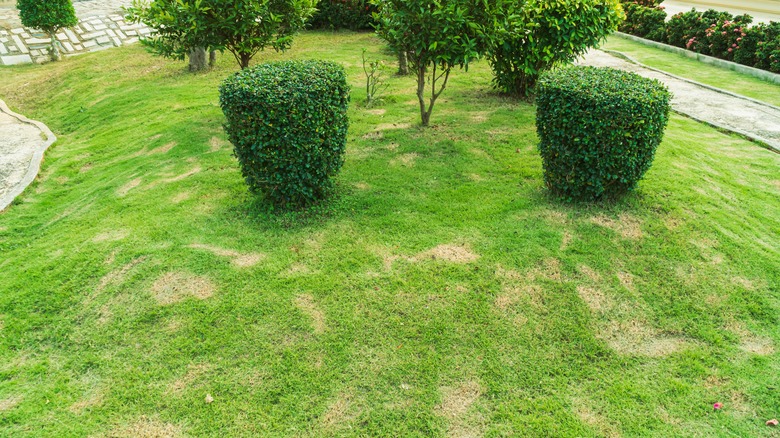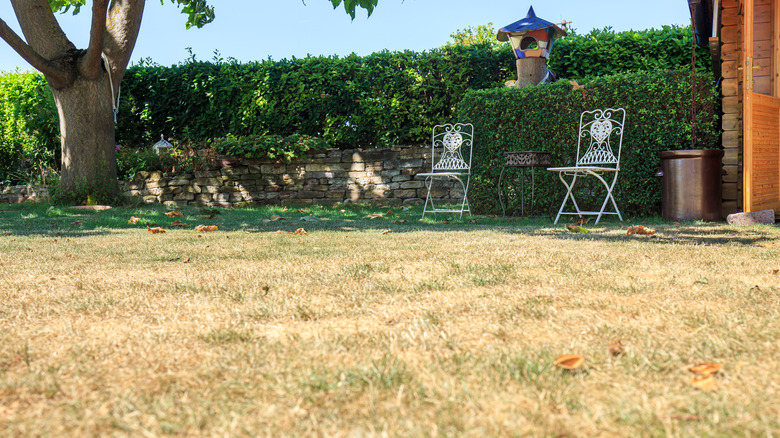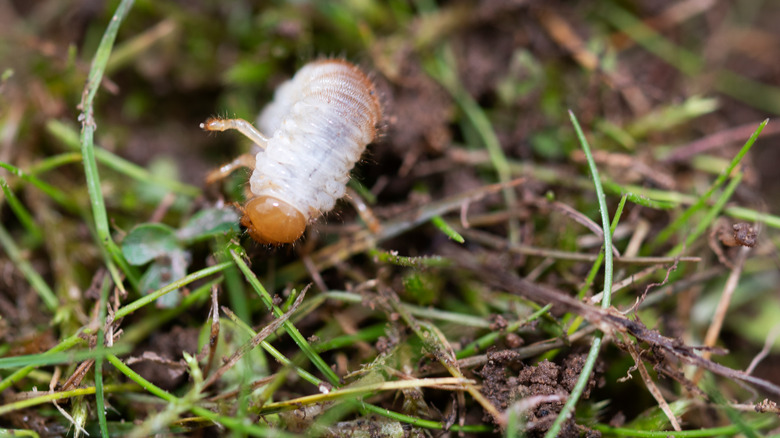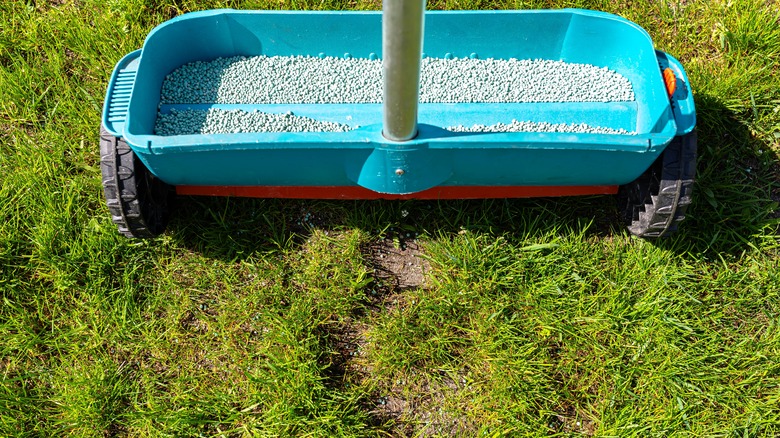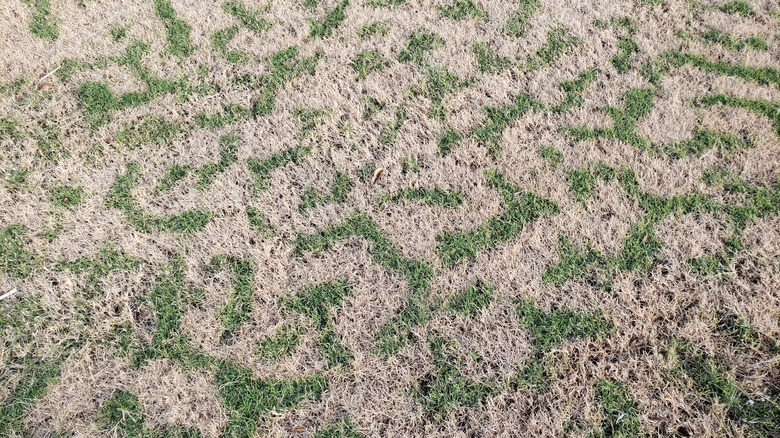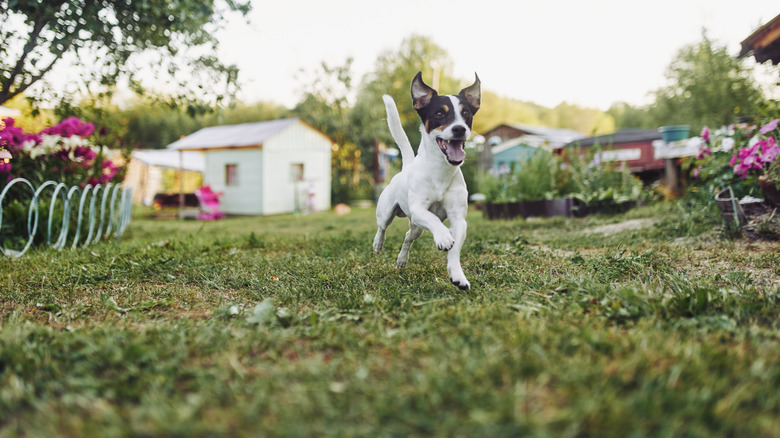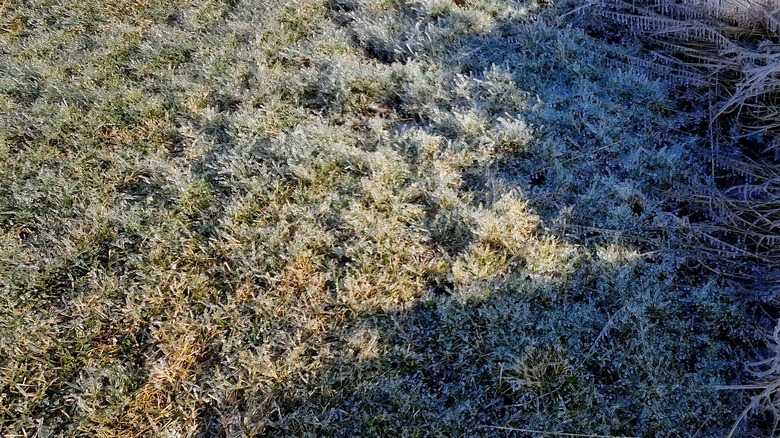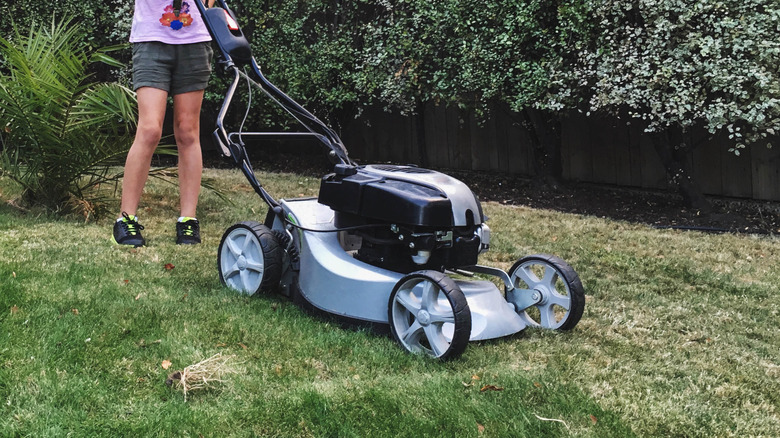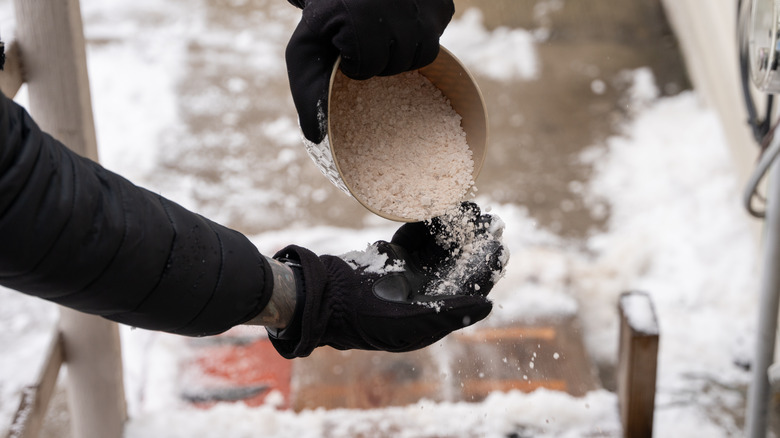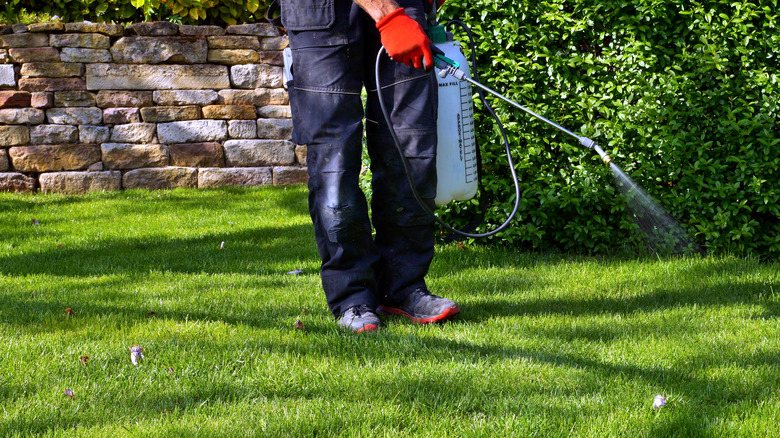10 Reasons For Unwanted Brown Spots In Your Lawn & What You Can Do About It
Picture this: You're tucked in your lawn chair, breathing in the fresh air and taking in the verdant lushness of your lawn. But then you are jolted out of your reverie, thanks to an ugly, brown spot that has materialized (seemingly overnight?) on your turf. Obviously, there's no gnomic sorcery at play, and all arrows point at you having missed the early signs. Perhaps it's the notorious brown patch disease clawing its way through the neighborhood. Or, maybe you've misunderstood your lawn's watering or fertilization needs, causing it to display its stress through ugly brown patches. However, that doesn't take the sting out of the situation or resolve it.
Getting to the bottom of your lawn's browning situation is extremely arduous since pests, diseases, nutrient deficiencies, soil compaction, and unpredictable environmental conditions can complicate the problem with overlapping symptoms. So, to help you restore your lawn's aesthetics and get back in the good books of your neighbors and HOA, we exclusively got in touch with Rob Palmer, Brand President at Lawn Squad. He elaborates in-depth on the root causes of these spotty eyesores and the ways to reclaim your greensward. Read on, for it's about time your lawn goes back to doing what it does best: Serving as a joyful, recreational space while aiding erosion check, noise reduction, air quality improvement, and flood control.
Thirsty or drought-stressed lawns turn dull and lifeless
"Lawns may easily turn off-color or brown when faced with prolonged lack of water or drought conditions," Palmer tells House Digest. The phenomenon starts with the green blades turning a tad blue, curling over, browning, and then completely losing their turgor as the water deficiency persists. In short, they go dormant from the drought stress. The symptoms are usually localized, with irregular patches concentrated around patios, driveways, slopes, or pathways. High temperatures, compaction, algal infestations, sandy texture, and thatch amplify the problem. Poor irrigation coverage doesn't help, either.
Besides, turfgrasses respond differently to drought. Palmer weighs in, "Bermudagrass in the south and turf type tall fescue in the north and transition zones handle drought conditions better than other species." Indeed, moisture-deficient tall fescue retains its green hue for nearly 28 days compared to a measly week for Kentucky bluegrass. Clearly, incorporating drought-resilient grasses in your seed mixes is the way forward. Homeowners must also take stock of their irrigation systems, meaning check for crooked, blocked, or stuck heads, positioning, and water pressure to ensure they're functioning optimally and not stressing out the lawn. Cutting your grass to a raised height of 3.5 inches should help. "It may also be necessary to increase the frequency and duration of the watering cycles to every other day (or daily) for about 45 to 60 minutes per area of the lawn," interjects Palmer. Otherwise, wait for the rains.
Insects or disease-causing pathogens may play foul
Brown spots in the spring season usually denote the presence of pests, not drought stress. But if you would like to be sure, drive a 6-inch long screwdriver into the soil and check for moisture. "Pest activity can impact a lawn rapidly if not controlled, changing a happy lawn into a sad one," Palmer shares. "Insects and pathogens feed on tender yet vital parts of the grass plant, altering its ability to function." Unfortunately, there is a horde to watch for, such as grubs, mites, sod webworms, and cranberry girdlers.
To illustrate, masticated brown blades and the surfacing of white insects as you walk on the lawn indicate sod webworms. In contrast, if the brown grass peels out easily and is missing its roots, grubs are to blame. But if it's neither, fungal pathogens may be the culprits. Brown patch lawn disease affects many cool-season grasses, and the high humidity-temperature combination intensifies it manifolds. Dollar spot and snow mold are other contenders, prevalent throughout the summer or post-winter in wet conditions, leaving brown patches in their wake.
"To keep your lawn from browning, implement good IPM or Integrated Pest Management practices," advises Palmer. "This begins with cultural practices like proper watering, good mowing techniques, and annual aeration." A solid nutritional program is equally necessary, as "under-fertilized lawns tend to be easy targets for pests." Disease or pest infestations can be corrected through fungicide or insecticide applications.
Heavy trampling and compaction reduce grass to brown patches
"Compaction and traffic wear can be a major contributor to lawn browning," explains Palmer. The constant foot and vehicular traffic physically injures the grasses through repeated trampling, causing their subsequent impairment. "The grass plants may even lose their ability to recover and die, requiring the need to replant new grass." Besides, all that nature-esque walking and running compact the soil underneath. As is known, compaction shrinks the soil pores. "This restricts water, air, and nutrient movement within the soil profile where grass roots grow," describes Palmer.
As a consequence, the roots put on shallow growth, and the lawn, especially around the footpaths, thins out, browns, and stops responding to fertilizers. In all, you end up with a significantly weaker turf, prone to environmental stressors and diseases. However, your turf's genetic wear tolerance plays a role, too. For instance, hybrid bermudagrass and kikuyugrass don't wear down easily, and when they do, are quick to bounce back. On the flip side, creeping bentgrasses show poor resistance and feature high on the list of grasses that should be avoided for a lush, green lawn.
So, how do you redress the traffic problem? Palmer says, "It comes down to good cultural practices — conducting annual lawn aeration during peak growing seasons helps relieve compaction." Moreover, limit the traffic or redirect it closer to asphalt or concrete pathways. Also, "alter mowing patterns and change mowing direction when using a riding lawnmower," advises Palmer.
Nutrient-starved lawns develop brown spots
Given the gazillion stresses thrown their way, mowing and traffic being foremost, lawns require copious amounts of nutrients to ride out the wave and maintain their verdant hue. The turf might also face immense resource competition from pernicious weeds or adjoining shrubbery. Plus, if you don't leave grass clippings on your lawn during (or after) mowing, your yard loses out on precious nutrients that are never replaced unless you fertilize. Alas, fertilizing your lawns isn't straightforward since much depends on the turfgrass variety, the soil's organic content, and shade.
Moreover, as soils differ greatly in their alkalinity and nutrient content across different US regions, starting without a soil test is often a recipe for a mottled brown, not the coveted emerald expanse. Palmer adds, "Without the nutritional levels necessary to perform some of the vital functions, such as photosynthesis and new leaf, shoot, and root development, grass plants can struggle to maintain a healthy green color." Of all, potassium holds primary importance, as its deficiency streaks the blades yellow, aging into brown, with the necrotic margins wilting progressively down to the shoot. The turf also becomes highly sensitive to extreme temperature variations and diseases. The only way out of the predicament is to "ensure your yard is on an adequate nutritional program for the types of grass growing in the lawn," insists Palmer. Resist the urge to overfertilize with nitrogen, or it can cause brown patch disease.
Dormant grass is naturally brown in its off-season
"Not every reason for browning grass is necessarily bad," clarifies Palmer. Sometimes, it's just the "grass's natural reaction to things like extreme heat or extreme cold and happens to protect itself from dying." In other words, the grass has gone to sleep, and the straw color is proof of that. Most lawns have cool-season grasses that grow best during spring and fall. "But in the peak summer heat, these cool-season species, such as Perennial Ryegrass and Kentucky Bluegrass, tend to go heat dormant due to the high temperatures," elucidates Lawn Squad's Brand President. Their defense mechanism may also kick in during extreme winters.
Warm-season grasses like zoysia and buffalograss aren't any different, often saddling their growers with the task of telling the difference between dead and dormant turf as the winter melts into spring. That's because they have little tolerance for cold temperatures and are willing to wait it out till it becomes passably warm. Remnants of annual weeds, crabgrass, in particular, may amplify the browning, although they tender little trouble if they're dealt with before seed production.
"As dormancy is a natural process, avoiding or preventing it is not necessarily an option if Mother Nature decides to crank up the heat or cold," concludes our expert. However, survival watering may become necessary, as an extended drought may damage the crowns, ruining the grass's recuperative potential — watering 1-inch monthly will generally do the job.
A free-for-all for dogs keeps the grass spotty and discolored
One surprising way you've been killing your grass, or at the very least turning it brown, is by letting your dogs roam free. Dog urine has vast amounts of nitrogen, which works similarly to overfertilization by burning the grass. This damage is more noticeable during spring because pets tend to form a habit of relieving themselves in the same lawn spot over the winter. The months-on-end usage naturally harms the grass, showing up as nearly 1-foot-wide tan circular patches, growing darker with use.
But if your dogs have missed the mark, you might come across several such patches coalescing into each other, forming an asymmetrical dead blotch that somehow is surrounded by highly lush green blades all around. These green plants have also likely outstripped their ilk in height, as the nitrogen drift (from the urine) was just the right amount to have them thrive. Curiously, if your area has a heavy rabbit presence, their feces can wreak similar havoc, discoloring your sward.
In case you manage to diagnose the issue before the turf is killed, watering it deeply might aid its survival. However, you'll want to train your pet to move its bodily business elsewhere. But if the grass is past its expiry, your only recourse is to pull out the dead blades, rake the soil, and reseed. Regarding the rabbits, consider switching to the Milorganite fertilizer they detest, but the grasses don't.
Winter desiccation shows up as brown zones in your lawn
The unwanted brown spots in your lawn, especially at winter's end or the spring's beginning, may be a consequence of winter injury and desiccation. The summer's drought conditions distress the turf, making it weak and highly vulnerable to the changing weather. So, when the mercury drops, the crowns fall into a freeze-thaw cycle in tandem with Mother Nature, dehydrating and dying in the process. However, the strawy patchwork becomes apparent only when the more resilient blades green up.
Poorly irrigated lawns (due to underwatering or uneven irrigation coverage) meet a similar fate, as do grasses with significant thatch accumulation. Sod may fall prey to winter injury if it isn't given sufficient time to establish itself or harden off. Disease-ridden turf doesn't fare any better. In a similar vein, winter desiccation occurs when dry winds and low humidity parch the dormant grasses dry. High daytime sun exposure and scant snow cover, particularly at higher elevations, worsen the situation. Warm-season grasses take the highest losses, turning brown initially but perishing when the situation goes out of hand.
Generally, an expected difference of over 20 degrees Fahrenheit between ambient and soil temperatures should put you on alert. Consider top-dressing the ground with sand or laying protective covers for much-desired cold protection. If your area has a history of winter desiccation, experiment with snow fences, windbreaks, or anti-desiccants. Regular aerification can rectify thatch build-up. If not, reseed.
Low mowing and dull equipment tears down the grass
Odds are you've noted your grass looking brown after mowing, almost as if it's readying itself to star in a post-apocalyptic film, nipping your grand idea of creating an enviable green expanse into a nasty bud. Ryegrass and fescue lawns showcase such brown uniformity in the highest measure. But what's fueling it? Scalping and dull blades. Experienced homeowners know no more than 1⁄3 of the turf should be removed at any given time during mowing, aka "scalping," nor should it be trimmed super low. Otherwise, the grasses, particularly in bumpy lawns, become frazzled and are shocked into turning brown.
Tall fescue takes the worst hit, necessitating reseeding while the stoloniferous varieties (think zoysia and bermudagrass) repair themselves with time. Dull mowing blades are another offender, as they have no qualms about leaving the grass a jagged mess with oodles of threads hanging dispiritedly from the affronted blades. Herein, the turf edges grow brown, with the lawns that have endured the worst of it appearing a ghastly gray. To add insult to injury, the pruned grass plants become predisposed to disease-causing fungal spores and pathogens.
Intuitively, correcting your mowing habits (read, trimming not too low) should restore your lawn to its former glory. Sharpening the blades after four sessions, or as the mower manual dictates, should ensure a clean cut. Your grasses will become better more at conserving water, moderating water bills as a bonus.
Salt runoff damages lawn edges
Turfgrasses are the go-to around walkways, sidewalks, and driveways in cold climates. That's because they help filter out the deluge of deicing salts smeared liberally on the snow to make the hardscape (and streets) usable. However, the high sodium content can quickly grow off-balance, turning against (and destroying) the very grasses tasked with keeping it in check. The tell-tale signs usually include browning grass tips in areas closest to the hardscaping and growing progressively greener away from it. Such salt damage impairs the grasses' ability to withstand pests and weed competition. Juvenile grass plants may have trouble reaching maturity.
To minimize your lawn's brown spots that have developed courtesy of salt runoff, start by switching to salt-resistant varieties; fine fescue grasses tend to show high salt tolerance. Tall fescue and perennial ryegrasses are other worthy alternatives. You must also ensure your lawn has good drainage and loose soil (minimal compaction). This will afford you the opportunity to flush out the salts, lest they become problematic. Avoid lumping the salt-treated snow on your turf while scraping it off the driveway. Aeration and reseeding may be necessary for dead patches. In the future, substitute sodium salts for calcium chloride-based deicers, alfalfa meal, or beet brine to abate the threat.
Non-selective herbicides gravely injure the lawn
Weeds are a menace, forcing the hand of many a lawn owner to use Roundup, Kleen-up, or any other handy non-selective herbicide when every other action to banish the pesky growth fails. However, mis- or overlapping applications can cost your grass dearly, stippling it in straw-toned, circular spots that stand out distinctively from the otherwise plush growth. You can usually tell apart chemical injury from pest damage as it crops up along the longitudes of application. The dead weeds further add to the nasty mess, darkening the tan color to a nutty brown.
The worst part is that switching over to selective herbicides doesn't exactly translate to the turf taking no damage. Indeed, there have been instances when a perfect-looking lawn turned brown shortly after the use of a selective herbicide, especially during summer months. As it turns out, although irrigation can mask a turf's drought stress (to an extent), it isn't sufficient to withstand the combined pressure. Consequently, the sandier and water-deficient lawn parts transform into coffee spots. Similarly, severely pest-infested grass blades become injured if subjected to the over-application of pesticides containing growth regulators.
So, opt for spot treatment for smaller infestations to reduce application overlap. Deal with overapplications by applying activated charcoal to the affected turf. Check the labels for the downtime necessary before the new turf is fit for treatment. Delay applications if the mercury breaches 85 degrees Fahrenheit or you expect a downpour in the ensuing days.
